Summary Report: May 2019 Survey on Workplace Accommodations in the Federal Public Service
Note to readers
The Office of Public Service Accessibility has endeavoured to ensure that this report is fully accessible, and alternative formats are also provided. To provide feedback on the accessibility of the report, email accessibility.accessibilite@tbs-sct.gc.ca.
Prepared for the Office of Public Service Accessibility, Treasury Board of Canada Secretariat
Supplier Name: Environics Research
Contract Number: 24062-20-377
Original Contract Date: 2019-07-22
Delivery Date: 2019-09-13
On this page
- Objectives and methodology
- Key findings
- Disability requests most often have to do with changes in health or personal circumstances; supervisors are more likely to attribute them to difficulties carrying out job-related duties (difficulties relating to performance)
- Over three quarters of requests require a medical certificate; roughly one third require a formal assessment
- Wait times can be long for assessments and for receiving a decision on the accommodation request, even after all required information is provided
- For about a third of employees, the approved accommodation is not fully implemented and functional
- Two thirds of supervisors handled fewer than one request per year on average
- Supervisors most often start with Labour Relations; a quarter are unaware whether their employee had a similar previous accommodation
- Many functional areas can be involved in handling a disability-related request
- There is a gap in understanding regarding request implementation and the reasons for delays
- There are differences in perceptions of who is denying the request and the reasons for the denial
- Most employees do not appeal a rejected request: more than two in five say they believed it would make no difference and one in three feared negative consequences
- Compared with disability requests, non-disability requests are dealt with more quickly but are less likely to be approved
- The treatment of employees with invisible disabilities differs from that of employees with visible disabilities
- Observations, conclusions and opportunities for further exploration
- Recommended topics for future research
- Next steps
Objectives and methodology
Objective
The Office of Public Service Accessibility (OPSA) conducted a benchmark study of existing workplace accommodation practices in the federal public service, from both an employee and supervisor perspective, to identify common experiences, challenges and practices. This study helps identify opportunities to remove barriers and improve the process for work-related accommodations so that employees can contribute to their full potential as valued team members.
Methodology
OPSA conducted an online survey between May 6 and 24, 2019, with employees and supervisors who requested accommodation in the past three years across Canada. The survey required 20 to 30 minutes to complete, with 20 to 27 questions for the employee survey and 21 to 29 questions for the supervisor survey. The questions were designed to elicit information about respondents’ understanding of the facts related to their experience. The survey was anonymous; therefore there is no direct correlation between employees’ and supervisors’ individual responses, because respondents in each group may have been reporting on their experience related to different accommodation requests.
A total of 5,245 surveys were completed by 4,933 different individuals:
- 1,832 surveys were completed by supervisors who requested an accommodation for an employee
- 3,413 surveys were completed by employees who requested an accommodation for themselves
- 312 individuals answered a survey as both a supervisor who requested an accommodation for an employee and as an employee who requested an accommodation for themselves (counted in both totals)
Reporting
The introduction to the survey described disability-related requests, so some people whose request was for another reason may not have participated (thereby under-representing these cases in the final data). Unless otherwise noted, the results in this presentation deck exclude accommodation requests that do not involve a disability. In total, 1,753 of 1,832 (96%) of supervisor requests and 3,247 of 3,413 employee requests (95%) involved a disability.
Key findings
- Departments require guidance, communication tools, and access to expert advice and support to help them navigate the accommodations process.
- Gaps exist between knowledge and perceptions on the part of both supervisors and employees, which suggests room for improvement in communication.
- Employees may be asked repeatedly to provide medical certificates and undergo formal assessments to prove their need for accommodation.
- Delays in completing the accommodation process can have negative implications for employee productivity, morale and health.
- Employees who are denied accommodation reported that they didn’t appeal the decision because of concerns about reprisal, damage to career prospects, negative impacts on relationships with management or a belief that it wouldn’t make a difference.
- Further exploration of the roles and responsibilities of the multiple, diverse functional areas involved in the accommodation process may highlight opportunities to clarify accountabilities, improve practices, and increase efficiency, timeliness and consistency in the resolution of accommodation requests.
Disability requests most often have to do with changes in health or personal circumstances; supervisors are more likely to attribute them to difficulties carrying out job-related duties (difficulties relating to performance)
| Primary reason prompting a disability accommodation request | Employees | Supervisors |
|---|---|---|
| Change in personal health or circumstances | 57% | 55% |
| Difficulties carrying out existing job-related duties | 19% | 27% |
| Change in general office workspace | 14% | 12% |
| Starting a new job or existing duties changed | 5% | 4% |
| Staffing process | 2% | 1% |
| Change in job-related processes, supervisor, co-workers or clients | 1% | Less than 1% |
| Change in general administrative process | 1% | Less than 1% |
| Another reason | 6% | 3% |
Source:
- Q3A-G/Q31A-G. For which of the following activities did the employee request an accommodation? / For which of the following activities did you request an accommodation? (Includes only disability accommodation requests: supervisor n=1,753; employee n=3,247)
Over three quarters of requests require a medical certificate; roughly one third require a formal assessment

Figure 1-2: Text version
Medical evidence required for employee requests: A bar chart providing results from employee requests: Medical certificate required 77%, Formal assessment required 34%
Medical evidence required for supervisor requests: A bar chart providing results from supervisor requests: Medical certificate required 79%, Formal assessment required 41%
Employees with an invisible disability are more likely to be asked for evidence:
- 87% were required to get a medical certificate
- 44% were required to get a formal assessment
Source:
- Q14/Q41. Was your employee / were you required to provide a medical certificate or other evidence to support their/your accommodation? (Includes only disability accommodation requests: supervisors n=1,753; employees n=3,247)
- Q17/Q44. Was your employee / were you required to participate in a formal assessment by a medical doctor or specialist from Health Canada or outside of the public service? (Includes only disability accommodation requests: supervisors n=1,753; employees n=3,247)
Wait times can be long for assessments and for receiving a decision on the accommodation request, even after all required information is provided
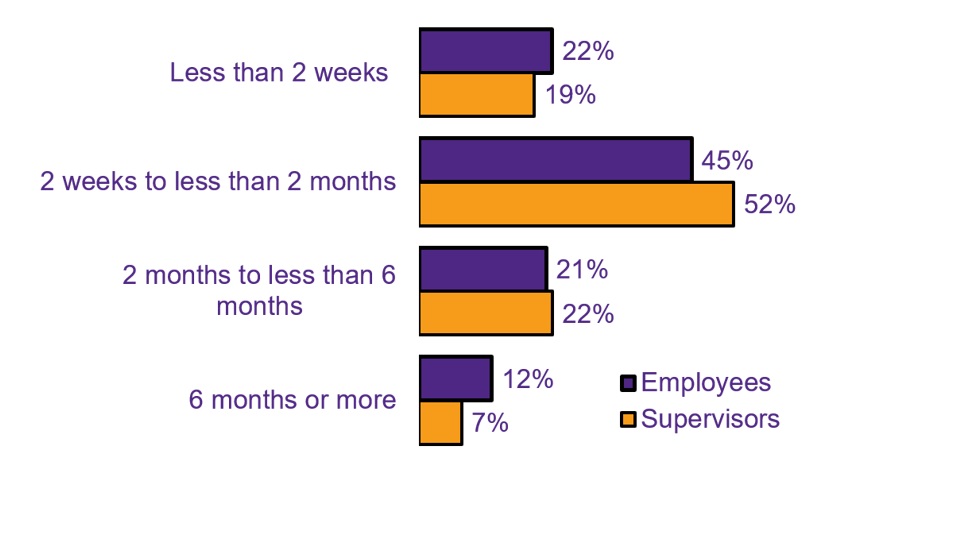
Figure 3: Text version
A bar char of wait times for a formal assessment. Employee results: Less than 2 weeks 22%, 2 weeks to less than 2 months 45%, 2 months to less than 6 months 21%, 6 months or more 12%. Supervisor results: Less than 2 weeks 19%, 2 weeks to less than 2 months 52%, 2 months to less than 6 months 22%, 6 months or more 7%.
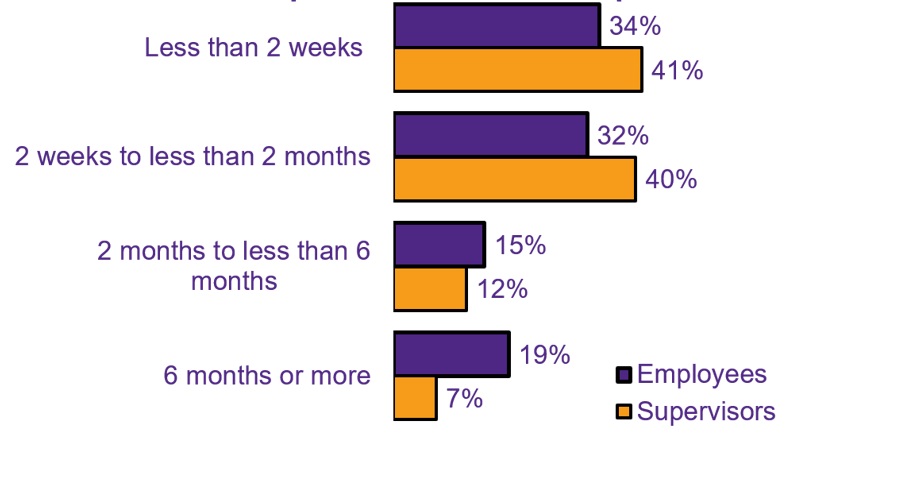
Figure 4: Text version
A bar char of wait times for a decision on an accommodation request after all required information was provided. Employee results: Less than 2 weeks 34%, 2 weeks to less than 2 months 32%, 2 months to less than 6 months 15%, 6 months or more 19%. Supervisor results: Less than 2 weeks 41%, 2 weeks to less than 2 months 40%, 2 months to less than 6 months 12%, 6 months or more: 7%
Source:
- 20/Q47. How long did you and your employee wait for the formal assessment to be completed by a medical doctor or specialist from Health Canada or outside of the public service? / How long did you wait for the formal assessment…? (Includes only disability accommodation requests: supervisors n=720; employees 1,103)
- Q21/Q48. How long did it take to receive a decision for this accommodation request after you / your employee provided all required information…? (Includes only disability accommodation requests: supervisors n=1,753; employees n=3,247)
For about a third of employees, the approved accommodation is not fully implemented and functional
| Ultimate outcome of accommodation process | Employees | Supervisors |
|---|---|---|
| The approved accommodations are in place and working effectively | 45% | 62% |
| Net: Fully implemented and functional accommodation solution not obtained | 34% | 23% |
Approved accommodations in place but one or more needs to be reviewed or adjusted |
11% | 9% |
Some accommodations approved and in place, other accommodations not approved |
7% | 6% |
Some accommodations approved and in place, others approved but not yet in place |
6% | 4% |
Accommodations process is still ongoing or still waiting on decision |
6% | 1% |
Accommodations were approved but none are in place yet |
5% | 3% |
| Accommodations were not approved | 8% | 2% |
| Approved accommodations in place but accessibility barriers remain | 6% | 3% |
Source:
- Q27/Q55. Which of the following best describes your employee’s / your current situation? (Includes only disability accommodation requests: supervisors n=1,753; employees n=3,247)
Two thirds of supervisors handled fewer than one request per year on average
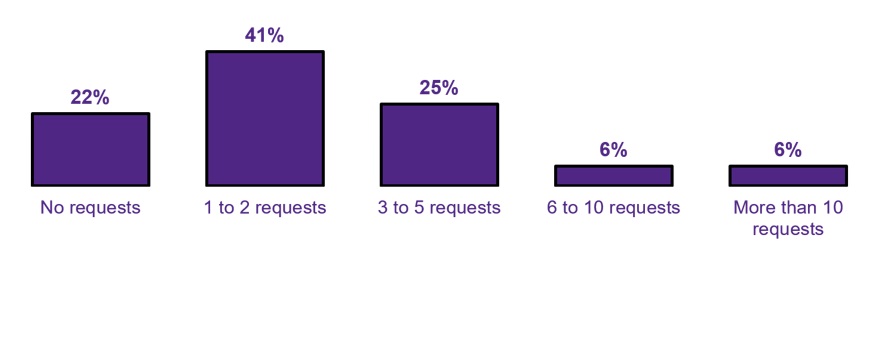
Figure 5: Text version
A column chart showing the results: No requests 22%, 1 to 2 requests 41%, 3 to 5 requests 25%, 6 to 10 requests 6%, More than 10 requests 6%
Source:
- Q2. As a supervisor, how many workplace accommodations or accommodation plans were requested for your employees in the past three years? (Base: All survey participants who identified their role as a supervisor, n=2,346). Supervisors who said “no requests” were redirected to the questions for employees.
Supervisors most often start with Labour Relations; a quarter are unaware whether their employee had a similar previous accommodation
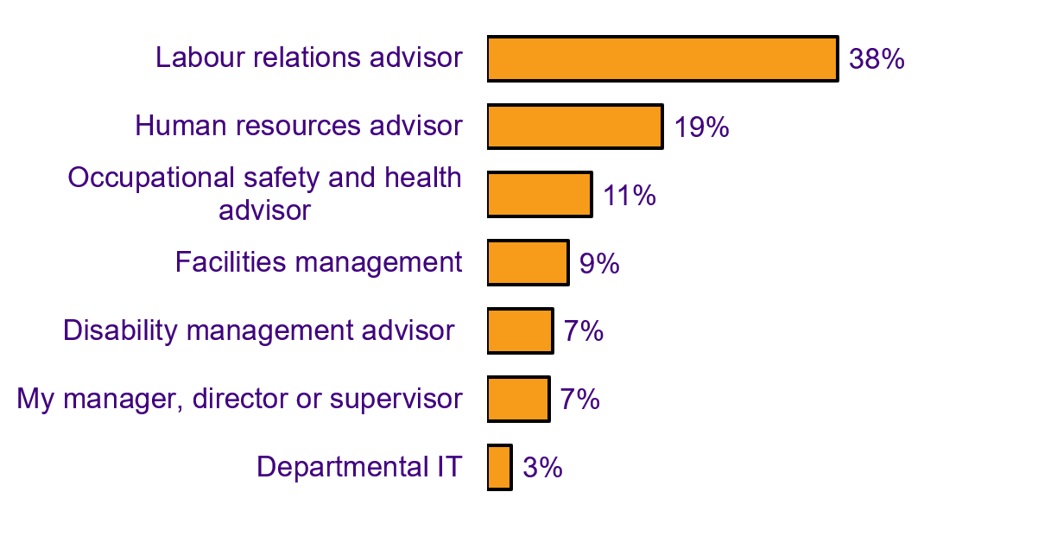
Figure 6: Text version
A bar chart of the results: Labour relations advisor 38%, Human resources advisor 19%, Occupational safety and health advisor 11%, Facilities management 9%, Disability management advisor 7%, My manager, director or supervisor 7%, Departmental IT 3%

Figure 7: Text version
A doughnut chart showing the results: Yes 28%, No 48%, I don't know 24%
Source:
- Q12. Which of the following functional experts was your first point of contact in processing your employee’s accommodation request? (Includes only disability accommodation requests: supervisors n=1,753)
- Q4. Did your employee have a similar accommodation previously, for example, in another department, in another position, or under a different supervisor in their current position? (Includes only disability accommodation requests: supervisor n=1,753)
Many functional areas can be involved in handling a disability-related request
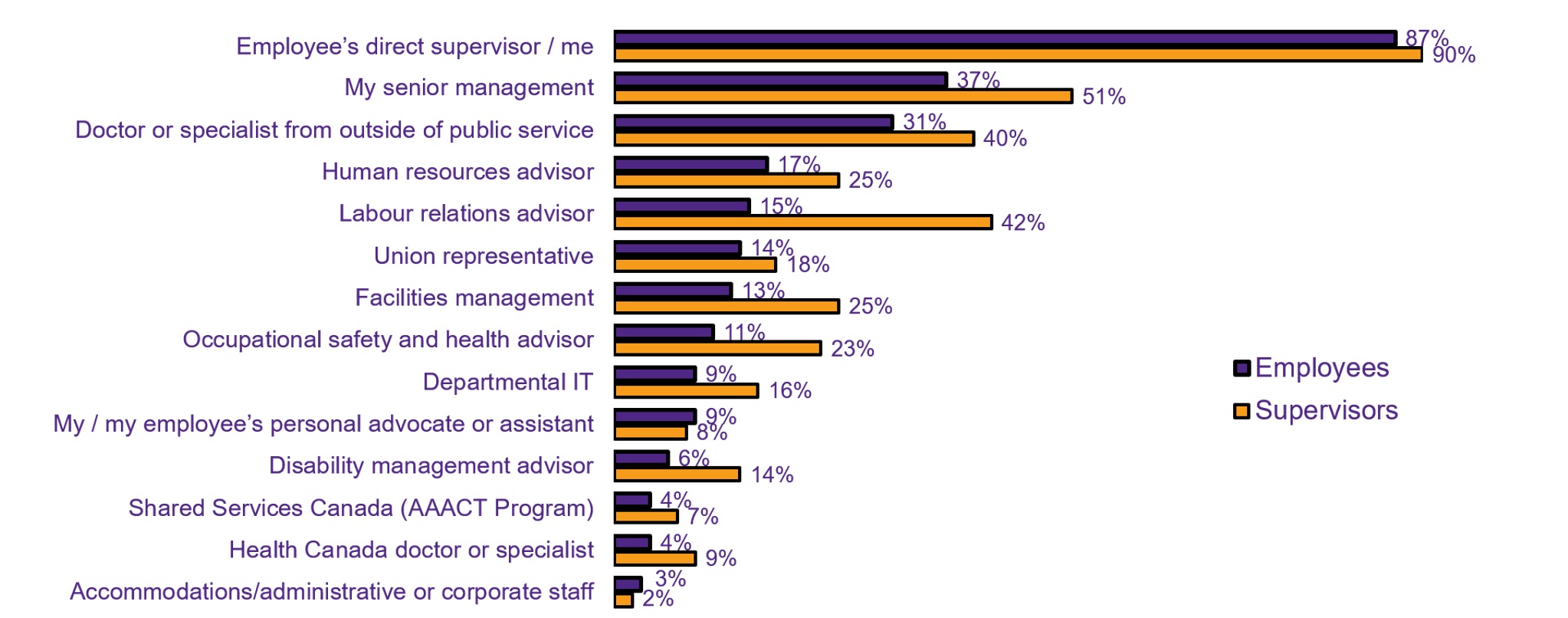
Figure 8: Text version
A bar chart showing the results. Employee results: Employee's direct supervisor 87%, My senior management 37%, Doctor or specialist from outside of the public service 31%, Human resources advisor 17%, Labour relations advisor 15%, Union representative 14%, Facilities management 13%, Occupational health and safety advisor 11%, Departmental IT 9%, My personal advocate or assistant 9%, Disability management advisor 6%, Shared Services Canada (AAACT Program) 4%, Health Canada doctor or specialist 4%, Accommodations/administrative or corporate staff 3%. Supervisor results: Employee's direct supervisor/me 90%, My senior management 51%, Doctor or specialist from outside the public service 40%, Human resources advisor 25%, Labour relations advisor 42%, Union representative 18%, Facilities management 25%, Occupational safety and health advisor 23%, Departmental IT 16%, My employee's personal advocate or assistant 8%, Disability management advisor 14%, Shared Services Canada (AAACT Program) 7%, Health Canada doctor or specialist 9%, Accommodations/administrative or corporate staff 2%
Source:
- Q13/Q40. To the best of your knowledge, who was involved in handling your employee’s / your accommodation request? Includes only disability accommodation requests: supervisors n=1,753; employees n=3,247)
There is a gap in understanding regarding request implementation and the reasons for delays
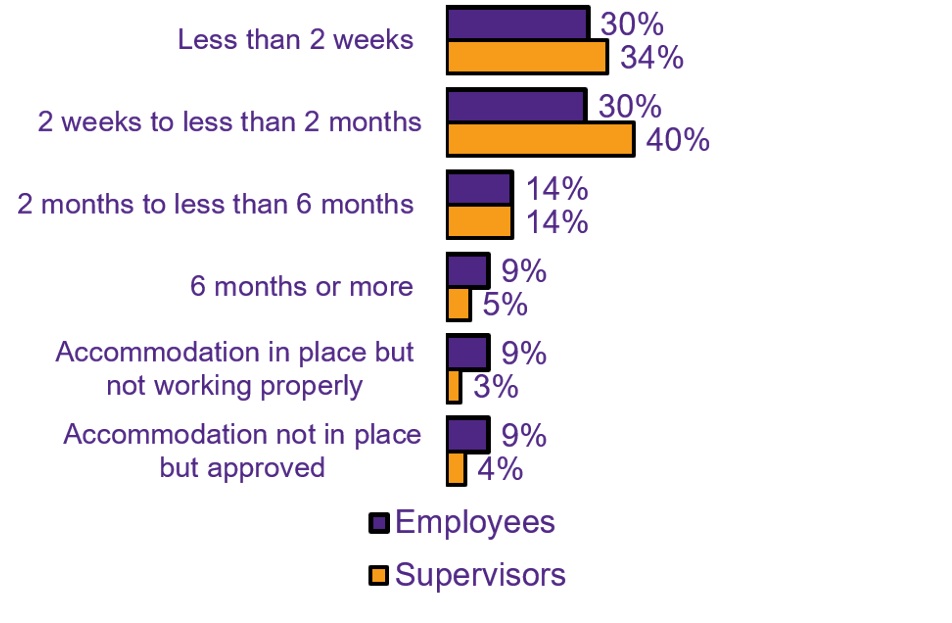
Figure 9: Text version
A bar chart showing the results for employee requests and supervisor requests. Employees: Less than 2 weeks 30%, 2 weeks to less than 2 months 30%, 2 months to less than 6 months 14%, 6 months or more 9%, Accommodation in place but not working properly 9%, Accommodation not in place but approved 9%. Supervisors: Less than 2 weeks 34%, 2 weeks to less than 2 months 40%, 2 months to less than 6 months 14%, 6 months or more 5%, Accommodation in place but not working properly 3%, Accommodation not in place but approved 4%
| Reasons for the delay in accommodation implementation | Employees | Supervisors |
|---|---|---|
| Delivery of required products or service delayed | 28% | 42% |
| Initial installation of products or services delayed | 17% | 27% |
| Backlog, bureaucracy or procurement delays | 15% | 8% |
| Internal service provider did not understand requirement | 12% | 17% |
| Communication delays | 10% | 3% |
| Management is uncooperative | 10% | 2% |
| Delay obtaining information from doctor or specialist | 8% | 23% |
| Issue with installation or set-up | 8% | 12% |
| Accommodation not compatible with existing systems | 6% | 10% |
Source:
- Q23/Q50. How long did it take for your / your employee’s accommodation to be put in place and working properly (including related training) after the request was approved? (Includes only disability accommodation requests: supervisors n=1,658; employees n=2,679)
- Q24/Q51. (To the best of your knowledge) What were the reasons for the delay if it took (or is currently taking) more than one month for your employee’s / your approved accommodation to be satisfactorily implemented? (Includes only disability accommodation requests: supervisors n=645; employees n=1,345)
There are differences in perceptions of who is denying the request and the reasons for the denial
| Common sources of request denial | Employees | Supervisors |
|---|---|---|
| Employee’s direct supervisor | 47% | 22% |
| Senior management | 36% | 53% |
| Labour Relations | 2% | 8% |
| Other | 9% | 18% |
| Still waiting on decision | 20% | 8% |
| Common reasons for denying accommodation request | Employees | Supervisors |
|---|---|---|
| Supervisor or senior management didn’t agree there was a need for accommodation | 31% | 15% |
| Supervisor did not agree with doctor’s findings | 24% | 9% |
| Supervisor not willing to vary policies | 19% | 7% |
| Operational or client requirements | 9% | 20% |
| Specialist report didn’t adequately demonstrate need for accommodation | 8% | 34% |
| No medical certificate provided | 5% | 13% |
Source:
- Q25/Q52. Who denied the accommodation request? (Includes only disability accommodation requests: supervisors n=95; employees n=569)
- Q26/Q53. What were the reasons for denying this accommodation request? (Includes only disability accommodation requests: supervisors n=95; employees n=569)
Most employees do not appeal a rejected request: more than two in five say they believed it would make no difference and one in three feared negative consequences
| Response to request denial (top reasons) | Employees |
|---|---|
| Net: Did not appeal | 69% |
Did not appeal: believed it wouldn’t make a difference |
44% |
Did not appeal: afraid of negative consequences |
32% |
Did not appeal: concerned about relationship with supervisor |
28% |
Did not appeal for other reasons |
12% |
Did not appeal because I left my job |
7% |
Searching for other jobs or department change |
5% |
Did not appeal due to extended sick leave |
4% |
| Net: Did appeal (or at least escalating or pushing) | 39% |
Requested advice from union representative |
27% |
Requested advice from doctor |
13% |
Filed formal complaint or grievance |
12% |
Escalated request to more senior manager |
11% |
Sought legal advice |
6% |
Repeated request or still trying to get it |
4% |
Process still ongoing or awaiting decision |
13% |
Source:
- Q54. How did you respond to your organization’s decision to deny your accommodation request? (Includes only disability accommodation requests: employees n=568)
Compared with disability requests, non-disability requests are dealt with more quickly but are less likely to be approved
| Supervisor requests: element | Disability requests | Non-disability requests |
|---|---|---|
| Involve Labour Relations | Often (42%) | Rarely (6%) |
| Employee requests: element | Disability requests | Non-disability requests |
|---|---|---|
| Decision times | Longer (34% less than 2 weeks) | Shorter (61% less than 2 weeks) |
| Approval rate | Higher approval rate (83%) | Lower approval rate (67%) |
| Union representative intervention upon denial | Often (27%) | Rarely (9%) |
| Do not appeal due to negative consequences | Sometimes (32%) | Often (55%) |
Source:
- Multiple questions; all respondents (n=4,933)
The treatment of employees with invisible disabilities differs from that of employees with visible disabilities
| Element | Visible disability | Invisible disability |
|---|---|---|
| Request involved: |
|
|
| Required to provide medical certificate |
|
|
| Source of medical certificate request |
|
|
| Required to provide a formal assessment |
|
|
| Reason for medical evidence: experienced health-related issues as a result of job-related duties |
|
|
| Reason for medical evidence: were experiencing difficulties carrying out job-related duties |
|
|
| Reason for medical evidence: disagreement between employee and management about what was required |
|
|
| Formal assessment wait time |
|
|
| Request approval |
|
|
| Reason for denial |
|
|
| Appealed or escalated the denied request |
|
|
Source:
- Multiple questions; employees with an invisible disability (n=623)
- Note: Proportions given are of the total number of employees responding about a disability-related accommodation made for themselves (n=3,247).
Observations, conclusions and opportunities for further exploration
| What did we learn? What can we explore further? | Evidence |
|---|---|
Table 10 Notes
|
|
Departments require additional tools, guidance and support (see “Next Steps”, below)
|
|
There are gaps in perspective and in the communications between supervisors and employees |
|
Employees may be repeatedly asked to provide evidence (prove) their need for accommodation |
|
Lengthy wait periods can have serious negative implications for employee productivity, morale and health |
|
Negative associations continue to hamper the accommodations process |
|
Further exploration into the roles and responsibilities of multiple, diverse functional areas involved in the accommodation process may highlight opportunities to clarify accountabilities, improve practices, and increase efficiency, timeliness and consistency in the resolution of accommodation requests. For example, in most organizations, Labour Relations is seen as a support for management, with a specialization in addressing performance and labour relations issues between employees and supervisors. Given that the survey did not assess the implications of different accountability structures, an opportunity exists to explore alternative models, such as functional leadership in a different area of Human Resources or under a senior manager with responsibility for multiple functions involved in the overall accommodation process (e.g., facilities management, information technology, contracting, etc.). |
|
Recommended topics for future research
The findings from the May 2019 Benchmarking Survey on Workplace Accommodation Practices in the Federal Public Service point toward additional questions and considerations to be examined in greater depth. Along with other research initiatives, the follow-up Benchmarking Survey (fall 2019) will explore a number of potential areas for further research, including:
- identifying guidance and processes to follow and expert advice and support that supervisors will find clear and useful
- the role of functional experts in the accommodation assessment and decision-making process, including potential issues related to mandate, training, organizational structure or process-related accountabilities
- the role of supervisors versus senior managers in the accommodation decision-making process
- degree to which the existing guidance may influence the number of requests for medical evidence or assessments
- the nature and impact of delays in the accommodation process and their implications for employees, and the determination of appropriate thresholds and/or service standards for different types of accommodation requests
- differences between experience and outcomes for employees with visible disabilities and those for employees with invisible disabilities
- the relationship between accommodation outcomes and harassment and discrimination experiences reported in the 2018 Public Service Employee Survey
- the existence of perception/communication gaps between employees and supervisors around the accommodation process
- the relationship between delays, denied accommodations and the use of extended sick leave by employees with disabilities, and the degree to which better tools and processes for tracking accommodation requests may improve the timeliness and efficacy of outcomes
Next steps
In March 2019, the Treasury Board approved the establishment of a new Centralized Enabling Workplace Fund (CEWF) to facilitate the management of workplace accommodations by investing in concrete, innovative projects designed to remove systemic employment-related barriers and improve workplace accommodation practices. The Benchmarking Study of Workplace Accommodation Practices in the Federal Public Service is a major component and will inform future CEWF projects to shape recommendations on a sustainable, consistent approach to workplace accommodations across the federal public service in Canada.
Other key projects to be carried out under the CEWF include:
- an employee accommodation “passport” to document needs and facilitate conversations with managers and experts about individuals’ accommodation requirements (a summary that will “travel” with employees to different positions)
- a lending library of adaptive devices that can be quickly deployed to meet the needs of new employees, to address temporary or short-term accommodation needs, and to facilitate experimentation with leading-edge devices
- a catalogue of approved adaptive devices and services that can facilitate the selection, purchase and implementation of commonly requested devices and services
- training for IT professionals on how to design and implement accessible systems
- training and guidance for employees and managers on how to create an inclusive workplace (for example, how to develop accessible documents and coordinate accessible meetings)
© Her Majesty the Queen in Right of Canada, represented by the President of the Treasury Board, 2021,
ISBN: 978-0-660-39035-2
